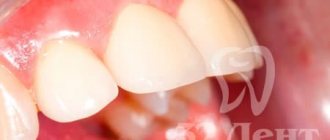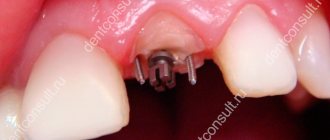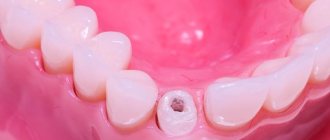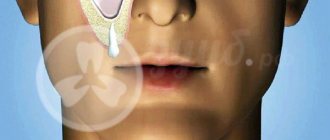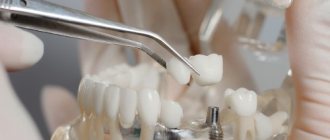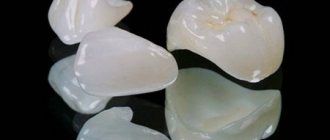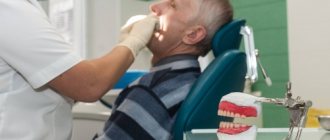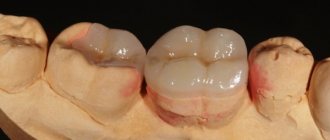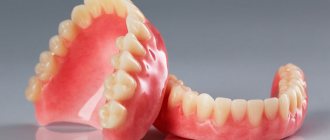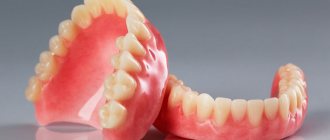Save our teeth!
Tooth decay, unfortunately, is an inevitable process that affects absolutely everyone. The sooner and more actively you start preventing it, the better.
Causes of tooth decay
- Caries.
Most often, dental problems occur due to an unbalanced diet, insufficient oral hygiene, and weakened immunity. As a consequence, the occurrence of this disease and fairly rapid destruction of the protective enamel layer and the entire tooth.
- Tooth deformation.
A lost filling can easily cause this painful process.
- Increased fragility of enamel.
It may be a congenital defect or a consequence of another disease - bruxism, when teeth experience increased stress due to friction against each other.
Filling teeth with inlays
Sealing on the pin is performed according to the following scheme:
- Initially, the specialist diagnoses the damaged tooth using various methods. The most informative is dental radiography.
- Radiography provides comprehensive data on: the depth and shape of the canal, the location of the roots. This allows you to select the pin of the desired shape and thickness.
- Dental restoration makes no sense without a sanitation procedure. An initial examination and identification of foci of infection and carious lesions will help avoid premature destruction of the restored tooth. The doctor treats all cariogenic areas and stops foci of inflammation.
- Procedures for preparing root canals for implant installation. The specialist removes the pulp (if required), expands the canals and performs mechanical cleaning. After cleaning with the instrument, it is necessary to rinse the canals with an antiseptic solution.
- Installation of the pin with the selected fastener. A custom or factory-made pin is placed in the root canal, and the remains are removed using a specialized instrument. The canal cavity is filled with dental cement.
- After installing the pin, the specialist begins restoration of the coronal part of the tooth.
- The doctor applies the photopolymer composite layer by layer and polymerizes it with an ultraviolet lamp. This is how the size of the tooth is gradually formed.
How to install pins
How to place a pin in a tooth? There are 2 options here - when the tooth was already depulped and when it still has a “nerve”. Let's take a closer look at both installation options. In the first case, the dentist uses a bur to remove part of the old filling compound from the canals, leaving the root tip sealed, and installs a pin. If pathological tissues are found under an old filling, they are first removed and the tooth is treated.
How to install the pin in the second case? If the pulp is preserved (it does not matter in what condition - normal or inflamed), then depulpation and expansion of the canals are carried out. If necessary, pulpitis and periodontitis are treated - then the patient can walk for 1-2 weeks with the medicine under a temporary filling. Then the canal is filled about a third, and after that the rod is fixed at the root.
Filling on a pin in different types of teeth
The advantages of the method lie in the integrity of the structure. If there are no moving or multi-layered parts, the structure appears more durable.
When installing a filling on a pin, there is no deformation or impact on the adjacent teeth in the row. Their enamel is not destroyed, the patient does not experience discomfort after the procedure.
The main disadvantages of the method include the formation of secondary caries. If the specialist used low-quality materials or paid little attention to the examination, then caries will form under the surface of the filling. The tooth is pigmented black, but the filling does not change.
A poor-quality filling in a tooth is clearly visible
Pros and cons of pins
The main advantages of pins are:
- Their installation requires a small amount of dental tissue preparation.
- You can restore a tooth in just one visit to the dentist.
- Installing a pin is relatively inexpensive.
- Reliable fixation in the dental canal.
If you have a problem similar to that described in this article, be sure to contact our specialists. Don't diagnose yourself!
Why you should call us now:
- We will answer all your questions in 3 minutes
- Free consultation
- The average work experience of doctors is 12 years
- Convenient location of clinics
Single contact phone number: +7
Make an appointment
Flaws:
- The fragility of the structure - on average, a tooth with a pin restoration is destroyed in 3-4 years.
- There is insufficient adhesion between the pin rod and the crown - under heavy load, the structure may separate.
- If the size of the structure is chosen incorrectly, dental tissue can be destroyed quite quickly.
Installation of a tooth crown. Types of crowns and fixation methods
Dental crowns help restore the chewing function of the tooth and ensure full load. The method has a large number of indications for use:
- A strong tooth root, but a significant absence of the crown part. A pin is installed in the root, and an individual crown is fixed onto it.
- Strong enamel pigmentation that cannot be bleached. The indication may apply to several teeth at the same time.
- The presence of progressive non-carious dentin diseases.
- Abrasion of tooth enamel; destruction of enamel under the influence of exogenous or endogenous factors.
How much does prosthetics cost?
How much does it cost to put a pin in a tooth? The price of the rod depends on the material and manufacturing method. An ordinary metal one can cost 100 rubles, titanium or zirconium dioxide - from 1000 rubles. Remember that multi-rooted teeth will require several rods, and you will also have to pay extra for the preparation of the canals and for the crown. The total cost of prosthetics with metal-ceramics will be at least 10 thousand rubles, with ceramics – about 25 thousand.
Your questions and answers
QUESTION Hello, my front tooth is broken. The doctor says that we need to put a crown on a pin. Is it possible to just get by with a crown? Oleg
ANSWER Hello, Oleg. In this matter, it is still better to listen to the opinion of a specialist. If it had been possible to place a crown without using a pin, then they would have done so. Most likely, the tooth is very badly broken or has been frequently treated for caries or filled. The pin in this case will strengthen the tooth and allow it to support the crown longer. By the way, there is another and better option for replacing the pin - this is a stump tab.
Preparatory actions
Before installing a crown, the doctor must diagnose and sanitize the oral cavity. If there is cariogenic damage on the tooth for restoration, then the doctor carries out treatment.
Teeth crowns are simply placed on the base
The next preparatory stage is turning the tooth or installing a pin. If the coronal part is completely destroyed, but the root is strong, a stump tab is installed. The stump tab strengthens the canals and allows you to securely fasten the crown.
Consequences, pain and complications after prosthetics
After the preparatory stage, installation of a rod or fixation of a crown, some patients feel discomfort - mainly pain. It is due to the fact that during the process of cleaning the canals, installing an orthopedic structure, and using a retraction thread, the surrounding healthy tissues were slightly injured. Normally, pain subsides within 3-5 days, less often – within 3-4 weeks (if pulpitis in a chewing tooth was treated).
If the pain only intensifies, becomes unbearable, the gums become very red, and an unpleasant taste or smell appears in the mouth, then it is likely that complications have begun. They are associated with poor-quality preparation of canals, manufacturing and installation of structures, and non-compliance with sanitary rules. Therefore, you must definitely contact the dentist.
Types of dental crowns
Modern aesthetic dentistry offers a large number of materials for prosthetics; each patient will be able to choose a material according to their capabilities.
What is better: a pin or a crown on a tooth: features and differences.
Today, technology has advanced far forward, and with their help it is possible to restore a damaged or destroyed tooth and even grow a new one, much stronger and more beautiful than the previous one. There are two main procedures: installing a post or a crown. This article provides a description of the methods, their comparison and recommendations for selection.
A dental pin is a rod designed to strengthen a damaged or dilapidated tooth. The device is installed in the root zone or directly into the dentin, and a hardening mass is built up on top. The main function of the pin is to strengthen the entire tooth so that it does not break under load on the filling or the extended part.
There are two types of pins:
- Metal (titanium, brass, palladium, steel, gold (with impurities).
- Non-metallic (fiberglass, ceramics, carbon fiber).
The shape of the device is conical, cylindrical, cylindrical, screw.
According to the method of fixation, the pins are divided into:
- Active - a solid rod has a special thread with which it is screwed into the dental tissue. This type of pin is used to restore a completely or almost completely destroyed tooth, since when used, a strong load is created that can cause the tooth to split.
- Passive - the rod is fixed in the root canal using a special reinforcing material. This type is used to strengthen the tooth after treatment.
Indications for installation: half-destroyed or completely missing natural dental crown, creation of support when installing removable and fixed dentures.
Contraindications: diseases of the blood and nervous system, inflammatory pathologies of the oral cavity, caries, cysts in the oral cavity, root length is less than the planned crown height, root walls are too thin (less than 2 mm).
A crown is a dental prosthesis designed to strengthen a tooth, restore its previous shape and give an aesthetic appearance.
Crowns are not installed on the front teeth, only on the chewing ones. For the front teeth, there are veneers - thin plates made exactly to the shape of the teeth and installed on their front part.
Devices are made of ceramics (porcelain), metal, cermets, and plastics.
Crowns can be placed on a post, a damaged tooth, or an entire tooth (to give your smile a beautiful appearance and make it snow-white).
- Restoring the shape of a tooth destroyed as a result of injury, caries and other reasons.
- Restoration of chewing functions.
- Strengthening dentin.
- Whitening and improving the appearance of teeth.
Contraindications to applying a crown are age under 18 years, inflammatory diseases of the oral cavity, caries, too thin walls of the visible part of the tooth, chronic diseases in the acute stage, abnormal bite.
Alveolitis
There is no need to rush to remove a decayed tooth. Dentists recommend restoration at the slightest opportunity. Even if you managed to save a small fragment or only the root. Otherwise, there is a threat of alveolitis - a disease of the processes on which the teeth are held. They are called alveoli.
When the wound left after tooth extraction is still open, the alveoli are practically not protected from external infections. In the infected socket of the extracted tooth, the blood thickens, the pain quickly intensifies, the temperature soars to 39 degrees, the wound festers, and the smell of the mouth deteriorates. You can avoid these troubles if you replace the removal of the problematic tooth with restoration using a crown or pin.
Advantages of stump inlays:
- two parts of the tab (under and above the gum) are one material, one-piece design, so its separation and damage is impossible, even if the tab is collapsible, its main part is solid:
- the inlay accurately follows the contours of the internal cavity of the tooth:
- minimal load on the walls of the tooth – protection from rapid destruction;
- uniform load on the tooth and tissues around it;
- it is possible to use an inlay even if the tooth root is bent;
- it is possible to use various materials (cobalt-chrome, gold-based alloy, zirconium dioxide), including for patients with an allergy to metals;
- it is possible to achieve unsurpassed aesthetic results when using metal-free inlays, for example, from zirconium dioxide;
- long service life - more than 10 years.
Implant-fixed crown
When implanting in one stage or with a protocol with instant loading, implants are used that consist of a single integral structure - one-piece. They can be intended for implantation into the cancellous or basal layer of bone tissue; types of implants are compression and basal. The crown is fixed with cement.
Implants are installed if there are indications:
- The tooth is subject to urgent or planned extraction;
- The root of the tooth is broken and requires removal;
- Contraindications to other types of prosthetics;
- The tooth has mobility.
Basal implants are installed when a tooth has already been removed, usually more than 6 months, there is a lack of bone tissue volume, inflammation that prevents classical implantation, and a smoking habit.
Contraindications:
- Inflammation of the gums;
- Chronic diseases that prevent surgical operations (oncology, heart disease, respiratory tract disease, immune system disease, etc.)
- Exacerbation of diseases that are relative contraindications;
- Deep carious lesions;
- Cyst, granuloma;
- Severe destruction of bone tissue;
- Violation of the process of bone tissue regeneration;
- Blood clotting disorders.
In the first six months after installation, the crown on the implant is made of lightweight materials so as not to disrupt the process of osseointegration. As a rule, it is plastic, it is cheap, has a good appearance, however, it quickly accumulates plaque and is not resistant to scratches. It is changed after the implant has stabilized - after 4-7 months. The most common materials for permanent crowns are metal-ceramics, ceramics and zirconium.
Expert opinion
Roman Borisovich Alekperov
orthopedic dentist
Experience: 24 years
Restoring a tooth using a core inlay is a more effective method of microprosthetics than using pins. Inlays are gradually replacing pins, the only exception being cases of pinning using innovative materials, for example, fiberglass. Unlike metal, it is highly biocompatible, while being strong and durable. However, if the root is curved or too thin, even a fiberglass pin will be useless - only a stump inlay can be used.
Disadvantages of dental posts:
- poor contact with the tooth root - under load or poor fixation, the pin may become loose;
- uneven load on the tooth root, which gradually leads to damage, especially to the walls of the tooth root;
- bone damage during installation - the pins have a wedging effect, that is, during installation, the boundaries of the teeth slightly expand, which affects the condition of the surrounding tissues;
- allergic reactions to the materials used to make the pins are possible;
- it is possible to develop secondary caries in the inner layers of the tooth, around the installed pin;
- short service life - about 2-3 years.
Stump inlays: advantages and disadvantages
Core inlays are structures that are created individually for each patient in a dental laboratory. To install them, the nerve of the tooth is first removed, all carious cavities are carefully removed, after which an impression is taken. Based on it, an individual pin is created that fits tightly to the walls of the root. The top of the inlay is covered with a dental crown or composite material. At the same time, fixing the crown to the core tab is the most reliable and durable method of tooth restoration.
Core inlays appeared several decades ago, but did not find much popularity due to the more complex installation process compared to pins and high cost. However, the number of advantages of inlays is many times greater than that of pins, so today they are used much more often.
